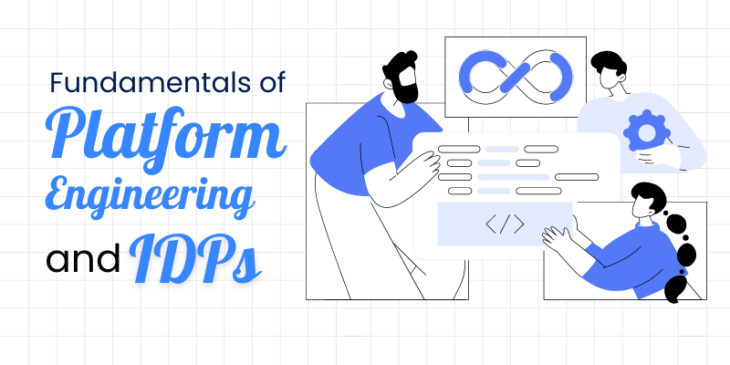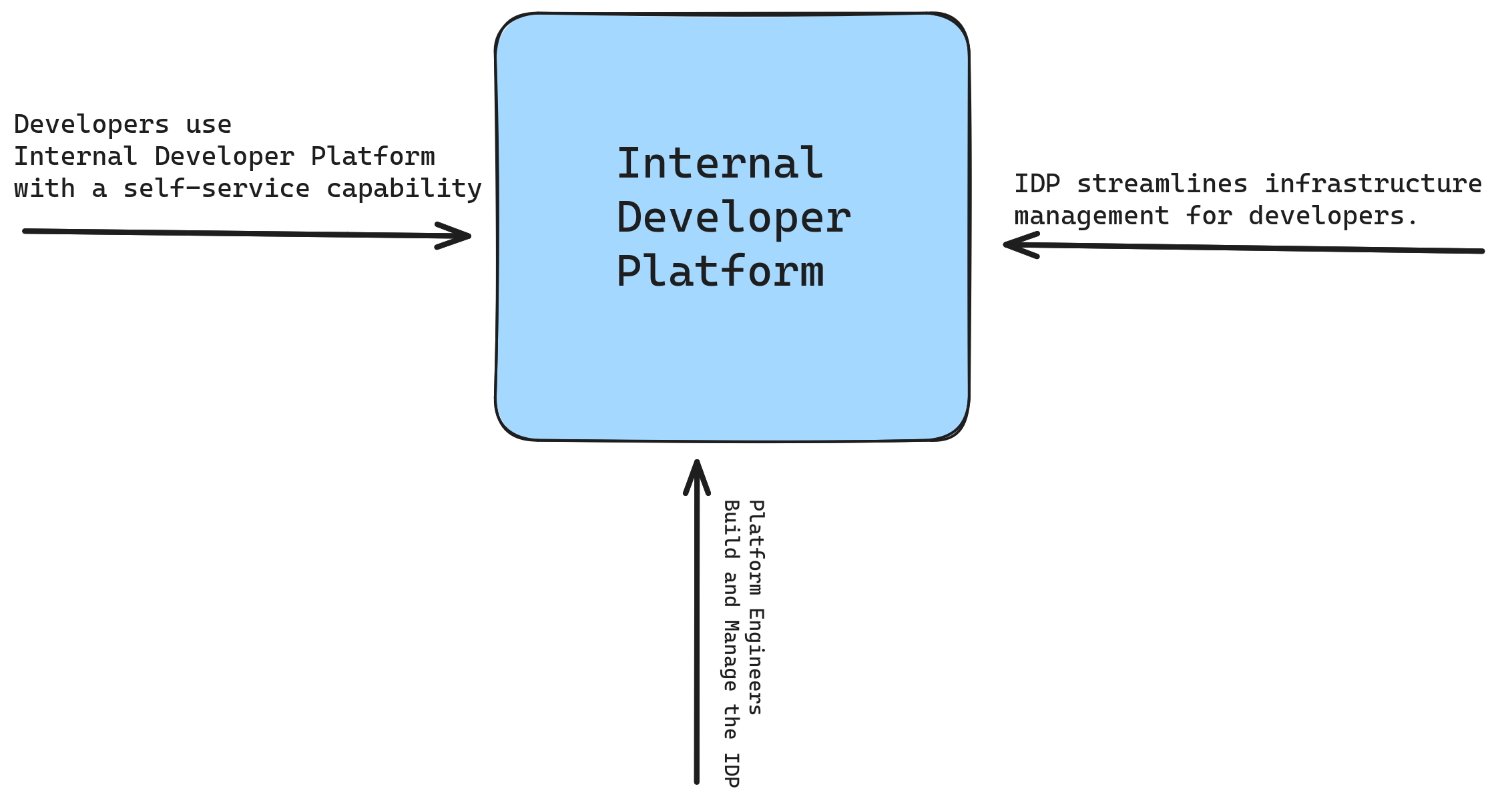
As reported by Gartner, 58% of IT leaders consider developer experience extremely crucial for their organization’s success[i]. Thus, making it a top concern for the C-Suite executives.
But, what does developer experience mean?
Developer experience is developers’ overall efficiency while using the tools, processes, and environment to build software.
Traditionally, developers spend significant time dealing with infrastructure complexities.
This slows development cycles and contributes to a poor developer experience (DevEx). To address this challenge, organizations are increasingly turning to platform engineering.
Platform engineers act as the infrastructure backbone for development teams. They build Internal Developer Platforms (IDPs), which empower developers through self-service capabilities.
In this blog, let us learn more about platform engineering, what it entails, and how your organization can approach platform engineering.
Exploring the Relationship Between Platform Engineering and IDPs
Platform engineering is an approach to developing and managing the platforms that facilitate efficient software development and delivery. This discipline encompasses tasks such as infrastructure management, tooling, and automation, and creating Internal Developer Platforms (IDPs) to streamline developer workflows.
At their core, IDPs aim to address the challenges and inefficiencies developers often face when building and deploying software. These challenges may include time-consuming tasks such as server provisioning, environment configuration, and managing dependencies.
IDPs automate and standardize these processes, so that developers can focus more on writing code and less on managing infrastructure.
These platforms act as a single toolbox for developers where they can build, deploy, manage, and monitor their applications.
Here’s a diagram that visualizes the role of IDPs in the development lifecycle.
With the primary goal of simplifying the software development lifecycle for developers, IDP platforms have multiple benefits which include:
| Benefit | Description |
| Increased Developer Productivity | Self-service tools in IDPs allow developers to provision infrastructure, deploy applications, and manage environments without relying on Ops teams. This frees up developers to focus on writing code and building features. |
| Faster Time to Market | IDPs allow streamlined workflows and reduce development bottlenecks that lead to quicker application delivery. This way organizations can get new features and products to market faster, gaining a competitive edge. |
| Improved Collaboration | IDPs provide a centralized platform for developers, testers, and operations teams to collaborate on projects. Also, shared tools and resources facilitate communication and transparency. |
| Enhanced Scalability | IDPs enable organizations to easily scale their infrastructure and development processes to meet changing demands. Resources can be provisioned and de-provisioned on demand which helps in optimized resource utilization. |
5 Key Features of a Well-Designed Internet Developer Platform
For development teams, choosing the right IDP for the deployment process is imperative.
A well-designed IDP can significantly boost developer productivity, streamline workflows, and ultimately accelerate software delivery.
But what features define an effective IDP?
Let’s explore the five key characteristics that empower developers and drive development success:
1. Self-service Provisioning and Infrastructure Management
An IDP can offer a self-service portal where developers can choose server configurations, operating systems, and databases with a few clicks. It empowers developers to provision resources (servers, databases) and manage their infrastructure needs on-demand without relying on IT or platform engineers. This eliminates delays and bottlenecks in the development process.
2. Version Control and Code Management Tools
An IDP can integrate with popular version control systems like Git or Subversion, allowing developers to manage code repositories directly within the platform. Here developers to track changes, collaborate on code, and revert to previous versions whenever required. This promotes code quality, facilitates teamwork, and simplifies troubleshooting.
3. Automated Testing and Deployment Pipelines
IDPs can integrate with continuous integration/continuous delivery (CI/CD) tools, allowing developers to define automated pipelines that execute tests and deploy code upon code changes. Furthermore, developers can automate repetitive tasks like running unit tests, integration tests, and deploying code to production environments. This frees up developer time, reduces the risk of errors, and ensures consistent and reliable deployments.
4. Monitoring and Logging Tools
An IDP can integrate with monitoring tools that track application metrics, server logs, and resource utilization, allowing developers to visualize and analyze data for performance optimization. Provides developers with real-time insights into application performance, infrastructure health, and potential issues. This enables proactive troubleshooting, faster debugging, and improved application uptime.
5. Security and Compliance Integrations
A well-designed IDP can integrate with security scanning tools, secret management solutions, and access control systems, allowing developers to secure code, manage sensitive information, and enforce access policies. Developers can implement security best practices and adhere to compliance regulations throughout the development lifecycle. This ensures secure applications, mitigates security risks, and helps organizations meet regulatory requirements.
How Platform Engineering Empower Developers?
Platform engineering removes roadblocks and empowers developers to be more productive and efficient, allowing them to focus on building high-quality software.
Here’s a breakdown of how each area achieves this:
- Developer Experience (DX) Optimization: This focuses on making the development process smoother. Platform engineers provide features like:
- IDE plugins are mini-programs that integrate with a developer’s coding software, automating tasks or offering helpful code suggestions.
- Code templates: Pre-written code snippets that developers can insert and customize, saving them time on repetitive coding.
- Comprehensive documentation: Clear and easy-to-understand instructions on how to use the platform’s features and tools.
- Infrastructure as Code (IaC): This automates the setup and management of infrastructure, like servers and databases. Instead of manually configuring everything, developers write code that defines their needs. This simplifies infrastructure management and reduces errors.
- Continuous Integration and Continuous Delivery (CI/CD): This streamlines the software development lifecycle. Developers make code changes, and the platform automatically runs tests. If the tests pass, the new version is deployed. This reduces manual work and allows developers to focus on new features and fixes.
- Observability and Troubleshooting: Platform engineers provide tools that give developers insights into their applications’ performance. These tools help developers identify and diagnose issues quickly, minimizing downtime and ensuring application health.
Are Platform Engineering and DevOps the Same?
Platform engineering and DevOps are closely related, but they address different aspects of the software development lifecycle. Here are key aspects that differentiate platform engineering from DevOps:
| Aspect | Platform Engineering | DevOps |
| Focus | Building and managing platforms and infrastructure services for developers and applications | Collaboration between Development and Operations teams to automate processes and improve communication |
| Scope | Broadly covers the design, implementation, and maintenance of platform services, including cloud infrastructure, container orchestration, CI/CD pipelines, etc. | Encompasses cultural aspects, tools, and practices for integrating development and operations, such as continuous integration, continuous delivery, automation, and monitoring |
| Goals/Objectives | Providing a stable and scalable platform for developers to deploy and run applications efficiently | Breaking down silos between development and operations teams, accelerating software delivery, and improving collaboration |
| Key Practices | Infrastructure as Code (IaC), containerization, orchestration, service discovery, automation, self-service platforms | Continuous Integration (CI), Continuous Delivery (CD), version control, infrastructure automation, collaboration tools |
| Tools & Technologies | Kubernetes, Docker, Terraform, Ansible, Prometheus, Grafana, Jenkins, GitLab | Jenkins, GitLab, Docker, Ansible, Puppet, Chef, Kubernetes, Slack |
| Culture | Focuses on building platforms that empower developers, enabling them to focus on building applications without worrying about infrastructure | Emphasizes collaboration, communication, and shared responsibility between development and operations teams |
| Metrics | Performance of platform services, availability, scalability, developer productivity | Deployment frequency, lead time for changes, mean time to recover (MTTR), change failure rate |
| Role of Engineers | Designing, building, and maintaining platform services, creating self-service tools for developers | Collaborating on automation, infrastructure design, and deployment processes, sharing responsibility for operations |
The Way Forward
To wrap things up, the teamwork between platform engineering and Internal Developer Platforms (IDPs) is a big win for software development. They make developers’ lives easier by giving them better tools and simpler processes.
As we look to the future, the growth of IDPs with Low-code/No-code features will shake things up even more in software development. This means more people will be able to get involved in building software.
Using a reliable IDP along with best-in-class platform engineering practices together, your development teams can work smarter, adapt quicker, and keep succeeding in complex software development initiatives.
Statistical References:
[i] Gartner
Is your business being held back by slow development cycles and inefficient infrastructure? Join industry leaders like Lenskart, Pine Labs, WheeBox, and more who trust BuildPiper for their infrastructure needs. Schedule a Demo Today!




